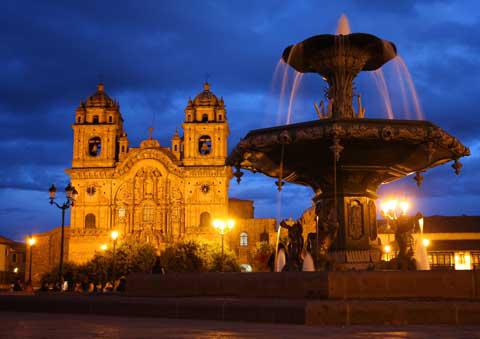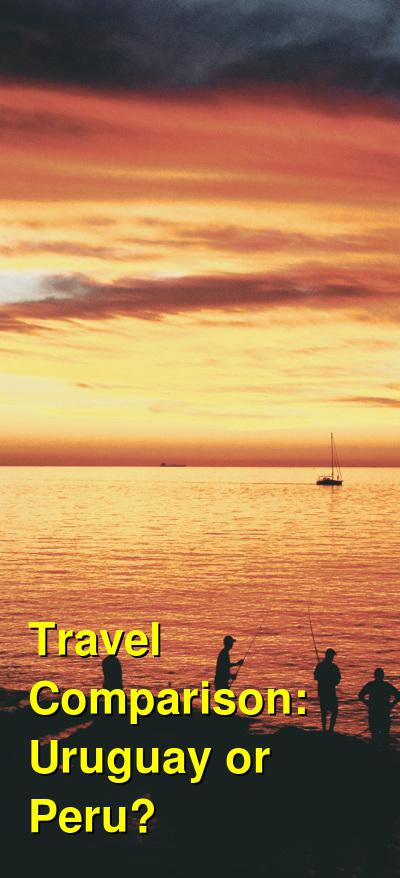Should you visit Uruguay or Peru?
Uruguay is much smaller than the rest of the Spanish speaking countries in South America. Many travellers ignore it and prefer to visit more popular destinations. Yet after two centuries living in the shadow of its neighbors, Uruguay is finally getting a little well-deserved recognition. Whether it is in Punta del Este or other satellite towns such as La Barra, Manantiales and Jose Ignacio, Uruguay's summer scene is about the beach. The beach destinations along the country's Atlantic coast are simply marvelous. However Uruguay also offers many other outdoors activities in its underpopulated landscape. From taking on the waves at Punta del Diablo, trekking with gauchos in Tacuarembo to kitesurfing at Laguna Garzon or hot air ballooning over vineyards, Uruguay's outdoor is opened to you and you might even end up being the only one there!
Thanks to Uruguayans' relaxed attitude toward life, Montevideo is a very chilled-out capital. Montevideo is a combination of colonial architecture, low-rise skyscrapers and 15 miles of beach-side rambla. Still wonder why it is home to about half the country's population? Even though the walkable city has a very sedated pace, it contains many great attractions to keep you busy, including picturesque Ciudad Vieja and Barrio Sur neighborhoods and the fun if sometimes overrun Mercado del Puerto market. As a prime beef exporter and consumer, Uruguayans take barbecues just as seriously as their Argentine neighbors. Expect to eat enormous amounts of tasty meat! Uruguay's Carnaval is also great fun! The two-month celebration, which starts mid-January, is largely based on candombe, dance and rhythms devised by African slaves in the 19th century. Drumming and energetic dancing are at the heart of every street party, a more grassroots affair than its Brazilian cousin. Visit Colonia del Sacramento and its Havana-esque ambiance that will take you back to the 1680's when it was founded by the Portuguese. This sleepy riverside town is one of Uruguay's oldest and has managed to preserve its 17th-century convent, lighthouse and drawbridge in the UNESCO-protected Barrio Historico. Another of the many laid-back town of Uruguay is Carmelo, which takes relaxing to a heightened level of chic. Located upriver and surrounded by vineyards and olive groves, visitors are entertained by water sports, golf, horse racing and polo.
In Peru, Cuzco, the capital of the Inca Empire is a popular destination for tourists. Its various churches from the colonial time, its many museums from the Inca Museum to the Chocolate Museum and its Plaza de Armas with numerous small gardens and benches make Cuzco a picturesque city. Many visitors only pass through Lima to go to Cuzco but with its historic center and its many museums, the City of Kings has a lot to offer. Lima is also famous for its cuisine and you will be able to enjoy a nice meal in front of the beautiful ocean landscape.
A trip to Peru is never complete without enjoying the beauty of the incredible Machu Picchu. Hidden between several mountains, Machu Picchu has a lot to offer in terms of architecture and stonemasons skills. If you're feeling adventurous you can take the Inca Trail but if you want to relax and enjoy the beautiful scenery you can also take the train from Cuzco.
Which country is cheaper, Peru or Uruguay?
Should I visit Uruguay or Peru? This is a popular question for many travelers. By figuring out which country is more expensive, you'll understand where you'll get more bang for your buck. A week in Peru can cost you about $529 (per person), while a week in Uruguay may cost you around $647. These differences become even more noticable if you plan to spend a longer time in the country. 10 days, two weeks, or even one month of travel to Peru or Uruguay can really add to your travel budget.
Accommodation is often cheaper in Peru compared to Uruguay ($27 vs. $35). Budget travelers usually stay in less expensive hostels and guest houses, while nicer hotels often appeal to families and upscale travelers.
Compare hotel prices here: Uruguay Hotel Prices and Peru Hotel Prices.
Or, compare hostel and guesthouse prices between Peru and Uruguay to find the cheapest accommodation here: Peru hostels and Uruguay hostels.
When comparing food in Uruguay vs. Peru they are not just different in cuisine, but also in price. Meal and restaurant costs in Uruguay ($38) are often cheaper than Peru ($28).
When is the best time to visit Uruguay and Peru?
 Farming is an important part of Uruguay's culture and economy.
Farming is an important part of Uruguay's culture and economy.
The best time to travel to Uruguay, especially if you plan to visit its coastal areas is during its summer months between November and February. While, travel is possible year-round, many of the beach resorts are closed for much of the year as soon as summer slips into autumn. If you decide to travel outside of summer, focus your trip on more cultural sites and cities. January and February are the warmest and driest time of the year to visit Uruguay so make sure to book very early to get the best choice of hotels on the beach without paying an astronomical amount. By March, most of the crowd has left Uruguay's beaches and much of the coastal infrastructure remains open, giving travellers access to vast quiet stretches of sand and ocean. Although autumn has started, the sea around Uruguay is generally at its warmest in April and May, making this a good time to visit the beaches and go snorkeling offshore. There are very few visitors in winter, from June to September, which doesn't necessarily make it a bad times to travel; particularly if the focus of a trip is more cultural or if you want to spot southern right whales. Visiting Montevideo and some of the small surrounding towns can be enjoyable experiences year-round. As Spring arrives towards the end of October, so does visitors on some of the country's beaches. Visiting Uruguay in November is particularly lovely. Montevideo is pleasantly warm and the beaches are quieter than in December, when holidaying Brazilians and Argentinians fill up Uruguay's beaches and hotel prices shoot up; particularly over Christmas and New Year.
Peru can also be visited all year round. The country experiences two main seasons. During the dry season between May and October, you will mostly get sunny days, bright blue skies in the Andes and chilly nights. This time of year lends itself to enjoying all the attractions Peru has to offer, from admiring Machu Picchu in the sunshine, to enjoying a boat trip on Lake Titicaca under vivid blue skies and trekking against backdrops of snow-capped mountains. While it is a wonderful time to be in Peru, it is also the high season meaning that early booking is crucial and sites or activities will be crowded. In December, the dry season comes to an end, but conditions are still pleasant. Between November and March visitors will notice more rain, with January and February being the wettest months to visit and the Inca Trail closing for the month of February. Travelling at this time does offer the advantage of fewer visitors, greener scenery and some lower rates for flights and hotels. Although the Amazon also experiences more rain between November and March, this should not deter you from visiting. The flora and fauna will still be abundant and there are always breaks in the showers.
Why is Uruguay more expensive than Peru?
The trendy resorts on the Uruguayan Atlantic coast, such as Punta del Este and Jose Ignacio are stunning but the prices are eye-wateringly high. These places are aimed at the local and international celebrities who vacation there, not backpackers on a tight budget. Make no mistake; prices in Uruguay are close to 'Western' prices and you should budget accordingly.
Peru can be very affordable with a lot of great value accommodation and food in the amazing places that every backpacker wants to visit such as Cusco, Lima and Lake Titicaca. Your biggest expense is likely to be your visit to the Machu Picchu or the Machu Picchu Inca Trail trek. Many of the costs in Peru will be far higher if you book online while abroad and bear in mind that the overall cost of travelling in Peru can be high due to the cost of the main attractions, which some travellers visit in very quick succession. A short loop around Lima, Cusco, Machu Picchu and Lake Titicaca is likely to cost you more than the same amount of time spent in another country's major city. However, it makes for an incredible experience with a lot of fascinating culture in a short period of time. Remember that in Peru, you can always eat for cheap. Lunchtime menus and cheap and tasty street food are a budget traveler's best friend. Most hotels and hostels also offer free breakfast.
What are the most expensive and cheapest cities and regions in Uruguay and Peru?
 The Cathedral Basilica of the Assumption of the Virgin, Plaza del Armas, Cusco, Peru
The Cathedral Basilica of the Assumption of the Virgin, Plaza del Armas, Cusco, Peru
Uruguay's capital city Montevideo and Atlantic coast beach towns Punta del Este, Atlantida, Piriapolis and La Paloma are relatively expensive due to a high cost of living and tourism. Inland locations are cheaper, but not necessarily where most international visitors would visit. Salto, located in northwest Uruguay, is an exception, as it is an affordable large city, with enough attractions in and around the city to make your travel interesting.
In Peruvian cities such as Lima, Arequipa, Trujillo, and Iquitos, a variety of options are available for food and accommodation, too. If you want more luxurious services and hotels, they will cost more, but plenty of cheaper businesses can also be found. Northern Peru is less touristy than the South and therefore has lower prices.
How you can save money when visiting Uruguay and Peru?
In Uruguay, save money on your food budget by shopping in the supermarkets. Also, water is sometimes as expensive as beer, or beer is often as cheap as water. In Uruguay, it pays to shop around as prices for items vary greatly. Prices can vary greatly from store to store even if they are right next to each other.
Cash is King. You will get the best deals if you are carrying US dollars. Prices can easily be negotiated when a Uruguayan shop owner knows you are dealing with US dollars.
Don't use your hotel's laundry service. The cost can easily work out to USD$35, which is sometimes as much as the actual hotel room itself. Check with the concierge before you send your laundry away or you might be in for a costly surprise.
Tips and gratuities aren't usually included in your food bill and an average tip should be about ten percent of the food bill. However if you give them a little more, even an insignificant amount to you, which probably means a lot to the people who work in Uruguay, you will make a local friend which will save you plenty of money and time when trying to figure out local customs, as well as finding reasonably priced accommodations and other special deals.
A great amount of money can be saved on food in Peru. Touristy restaurants, especially in hotspots such as Lima, Cusco and Arequipa, are more expensive than the typical restaurants frequented by regular Peruvians. Eat where the locals go and you will be surprised at how well you can eat in Peru on a budget. Eat your free breakfast if your hotel or hostel offers it with the price of your room. Sometimes it is just bread and jam, but better hostels will also have fruit, cereal, fresh fruit juices and coffee.
Finding out which ATMs charge the lowest withdrawal fees abroad is also a good idea before leaving. You can ask your bank for information you may find that your bank is part of the Global ATM Alliance, in which case you might be able to avoid some withdrawal fees.
An important rule when travelling to Peru is to watch out for scams. Learn about the types of scams in Peru and how to avoid them. A popular scam is the exchange of notes that are either false, broken or teared because a note needs to be in its perfect state to be accepted in Peru.
You should also set prices in advance whenever possible. If you don't agree on a price before accepting a service, you might be presented with an unexpectedly large bill. Peruvian taxis are a prime example. With no meters, it's up to you to negotiate a price before each cab ride and if you think the fare is too high, find another taxi.
Another great way to save money in Peru is to not be afraid to haggle over prices, especially in traditional markets where prices generally start high. You can sometimes even try to negotiating prices for hotel and hostel rooms if you are staying for at least four to five days.
Also try to learn Spanish, as it will make your ability to negotiate prices, haggle and avoid scams less limited. This being said, if you want to buy souvenirs, buy them at the source or in local markets rather than in touristy shops or airports.
Peru isn't a big tipping nation, and there are only a few occasions when a tip is expected, such as in a mid-range to upscale restaurants. Peruvian taxi drivers don't expect tips for example.
As for transport, flights aren't too expensive in Peru but they can add up. If time allows, take buses for long distances and preferably mid-range and top-end Peruvian bus companies for safety reasons. Not only will you see more of Peru, you'll also arrive at your destination with extra cash to spend on tours and entertainment. However, don't always assume that a tour is necessary. Many historic sites and natural attractions in Peru are easy to reach by public transport, normally a much cheaper option than private tours. Choose your tours wisely, as in many cases you can hop on a cheap minibus and find a local guide when you arrive at your destination. If you're going to travel by bus, consider traveling overnight. The top-end buses are comfortable enough to get a reasonably good night's sleep, saving you the expense of a hotel and wasted daylight hours on the road. Some roads in Peru are much safer during the day, so avoid overnighters if safety is an issue.


 Budget Your Trip is all about finding out how much everything costs so that you can travel cheaper and longer. Created by avid travelers Laurie and Bryan, our goal is to help you plan your next trip on the right budget. With average daily travel costs that are calculated from the budgets of real travelers, plus an analysis of hotel and tour prices, you can find out how much money you need to plan your next adventure. We also have plenty of travel advice, accommodation reviews, and activity suggestions.
Budget Your Trip is all about finding out how much everything costs so that you can travel cheaper and longer. Created by avid travelers Laurie and Bryan, our goal is to help you plan your next trip on the right budget. With average daily travel costs that are calculated from the budgets of real travelers, plus an analysis of hotel and tour prices, you can find out how much money you need to plan your next adventure. We also have plenty of travel advice, accommodation reviews, and activity suggestions.
